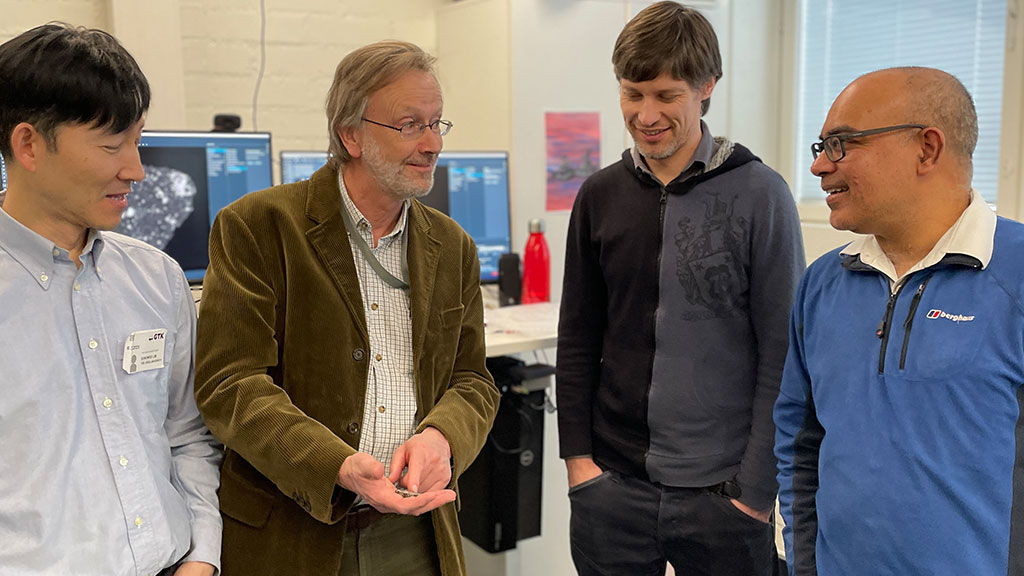Geology Plays an Important Role in Space
Understanding the geology of the Moon would play an important role when building a lunar base and settling on our nearest neighbour. For example, it plays a role in the extraction of water and oxygen from the regolith, growing plants, building blocks for the lunar base, and exploring and extracting the minerals and elements needed to build tools etc. Professor Mahesh Anand from Open University in the UK and Research Professor Alan Butcher from Geological Survey of Finland GTK with their teams are cooperating to make the future happen.

Limited resources are a source of innovations
Innovations are born more easily when resources are limited says Bricolage Theory of Entrepreneurship. If you have a limitless number of options and resources available when innovating, people tend to create a more expensive version of the solution they are trying to renew. Limited resources help you think in a new way. Artists have used the technique a lot. Picasso, for example, sought to draw a bull with as few strokes as possible, so that it could still be recognized as a bull. And he did an excellent job.
The limited resources are very tangible in Space and on the surface of the Moon. We cannot carry all the oxygen or water needed from the Earth, not even all the building blocks to make a lunar base. We need to make them on location. That is where geological know-how, innovations, and techniques step in.
Fully utilised Circular Economy is a necessity in space, and it feeds into processes on Earth too
When pushing our boundaries in finding meaningful applications and techniques to survive in Space, that is where the ultimate Circular Economy is happening. Nothing can be wasted at any point and all the reusing, recycling etc. needs to be in situ.
“This is likely to help develop, for example, mining to be more efficient and sustainable on Earth too so that, as little as possible is wasted. You cannot waste anything at any point of the process in Space. On Earth we go somewhere to dig 1% of gold and throw away 99% of the remaining material,” says Mahesh Anand.
“This is something Space will teach us. And we can bring the inventions back to Earth for the benefit of society,” he continues.
Practicing 3D printing of building blocks with volcanic ash
There is plenty of the Moon soil (regolith) to work on the Moon. Volcanic ash is the closest terrestrial analogue to the Moon’s regolith.
“The methods can be developed and experimented with that on the Earth to be as prepared as possible for the transition to extreme conditions,” says Alan Butcher from GTK.
GTK and OU researchers are developing together ways to 3D print building blocks with volcanic ash. GTK’s researcher Ian Corfe found the right composition for printing with ash and biowaste binder. For example, he 3D printed flowerpots using the volcanic ash that was also used in a plant growing experiment.
“It is important that the printing is done without any plastic or other petrochemical product since they are not available on the Moon,” says Mahesh Anand.
Water is like gold in Space – and there is water in the Moon
Humans need water to survive. Mahesh Anand and his research group contributed to the discovery of water in the Moon. However, this valuable “Space gold” is locked inside stones. We need to find ways to extract it from the stones. Those are also vital in getting oxygen – another thing humans need to survive.
The satellites that have orbited the Moon have detected OH (oxygen and hydrogen) molecules at the surface of the Moon. What we don’t yet know is whether there is water ice on the surface, one meter deep or even deeper still. That will be found out by future missions.
“Eventually we could also use oxygen as fuel for spaceships. Now the rocket fuel is liquid oxygen and hydrogen,” says Mahesh Anand.
The Moon soil needs to be utilized for growing food
GTK and the Open University has successfully grown plants in fresh volcanic ash from the island of La Palma, Canary Islands. In this first experiment seeds of rocket (a common type of plant used in salads) were successfully grown in various experimental mixtures of ash and compost contained within 3D printed plant pots made from the ash mixed with a biowaste binder.
Later analysis of preserved leaves by Alan Butcher showed that rocket leaf’s elemental uptake in the ash-rich plant pot was different from the compost-rich one.
“These preliminary findings tell us already that the plants have adapted themselves to take up certain elements preferentially, in the absence of other elements. For example, there is more phosphorus available in the mixture where there is compost in it than in more ash-rich mixtures. We don’t have the final answer yet, but this is where we are at the moment,” says Alan Butcher.
More information
Alan Butcher
Research Professor, Geological Survey of Finland GTK
alan.butcher@gtk.fi
